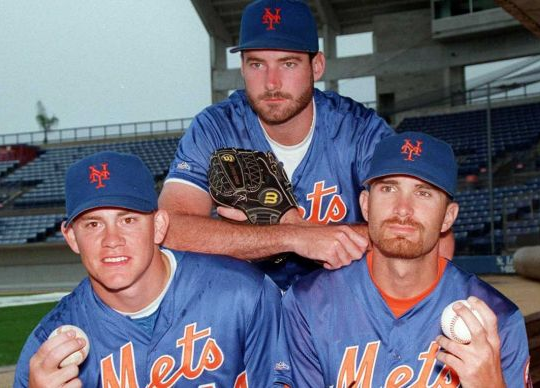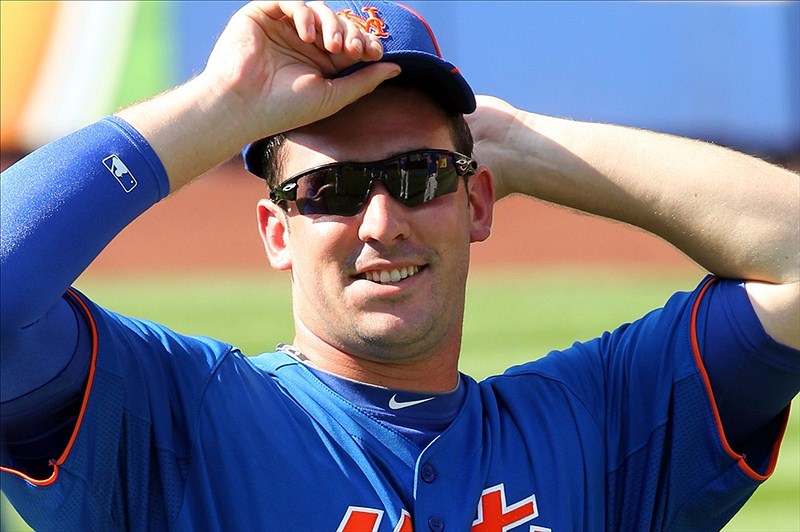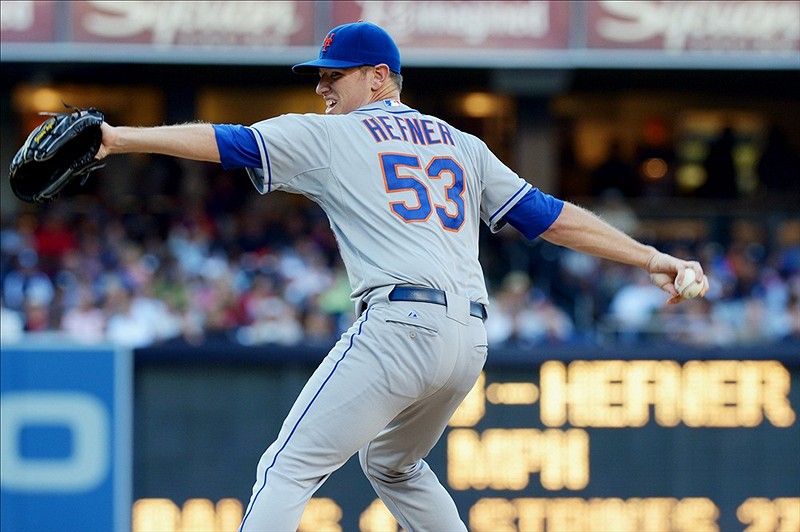 For the past 30+ years, the 5-man rotation has become a standard in Baseball. Initially, most teams used 4 regular starting pitchers making 36 or so starts per season (when healthy), with another 15 to 18 starts or so going to a “swing-man” (5th starter / long reliever) who only got a turn in the rotation when there were no off-days or (sometimes still scheduled) doubleheaders.
For the past 30+ years, the 5-man rotation has become a standard in Baseball. Initially, most teams used 4 regular starting pitchers making 36 or so starts per season (when healthy), with another 15 to 18 starts or so going to a “swing-man” (5th starter / long reliever) who only got a turn in the rotation when there were no off-days or (sometimes still scheduled) doubleheaders.
Has it been an effective method to reduce injuries to pitchers ? I don´t know. One thing to keep in mind is that only for the past 10 to 15 years max, Baseball teams have started to really protect the arms of their prized pitchers, especially young ones in their first couple of seasons in the majors or post surgery. Remember how “Generation K” was “abused” by Dallas Green & friends in the mid 1990s before this became common knowledge ? 120+ pitch starts have become a rarity in today´s game – basically only when a pitcher has a no-hitter or at least a shutout going or is on historic strikeout pace. So, the historical evidence one may bring up from examples of the 1970s, 1980s or 1990s as pros or cons for the benefit of 5-man-rotations vs. 4-man rotations seems flawed anyway. That besides much improved methods of detecting arm issues today (and handling them) than 20 or 30 years ago – so increased odds that arm issues will be detected – but not in career ending fashion like in old times. To avoid boring you with possibly outdated data, I suggest you Google studies on the 5-man or 4-man rotations where plenty of stuff can be found on the Internet – but is not too helpful IMHO.
Now, no team in Baseball I can think of, has ever really tried going with a 6-man rotation or at least a modified “5 ½ man-rotation” for an extended period of time. Except maybe for brief stretches of carrying a surplus starter here or there based on too many worthy rotation candidates with a DL returnee. Or at times late in a season with the team already out of contention to try out multiple options for future seasons. No team has specifically used this model over an entire season yet.
Before I explain why I believe 2013 would be a perfect time & situation for the Mets to give this idea an extended look, I will acknowledge that the main reasoning against the 5-man vs. the 4-man rotation obviously also applies to the 6-man rotation vs. the 5-man rotation:
“Your best starting pitchers get fewer starts and somebody who wouldn’t be good enough to even crack the rotation normally gets a bunch of starts instead”. Sure, if you have Justin Verlander or CC Sabathia, heck even RA Dickey on your staff, I very much get the point. And if depth is an issue anyway, it becomes an even larger one with 6 instead of 5 rotation gigs to fill.
However, the 2013 Mets as of today will have a starting rotation of mostly youngish pitchers, plus a couple of pitchers returning from shoulder injuries. In each case, one big goal has to be getting the arms as safely as possible through the typical injury nexus period (ages 19 through 24) and obviously try to avoid further injuries anyway, especially considering the financial implications.
One possible way to achieve that could be using a “5 ½” man rotation, i.e. 5 starters on regular turn and a spot 6th starter who chips in when there aren’t off-days or rain-outs to keep starters on 5 or 6 days of rest instead of the traditional 4 and otherwise serves as a long reliever.
While I acknowledge that the sample size is quite small, there are a couple of factors that point to a very significant upside in this approach. And given that the 2013 Mets may not be favored to go deep into October anyway, the downside seems pretty modest.
1. Higher Effectiveness and More Innings From Your SP
 Last season – whether it was by design or not – Jon Niese & Matt Harvey received an extra day or two of rest quite often. And the difference in performance was stunning (I only counted starts of regular 4-days rest vs. starts of 5 or 6 days of rest, leaving out starts with longer rest that usually won´t happen under normal circumstances).
Last season – whether it was by design or not – Jon Niese & Matt Harvey received an extra day or two of rest quite often. And the difference in performance was stunning (I only counted starts of regular 4-days rest vs. starts of 5 or 6 days of rest, leaving out starts with longer rest that usually won´t happen under normal circumstances).
Niese & Harvey made a combined total of only 13 starts on 4-days rest. Here are the combined numbers:
77.2 IP, 78 H, 49 R, 46 ER, 14 HR, 30 BB, 59 K´s, 5.33 ERA, 5.97 IP on average per start, 6.85 K´s per 9 IP
Meanwhile, the two made a combined total of 22 starts with 5 or 6 days of rest. Here are the numbers:
142.2 IP, 118 H, 38 R, 36 ER, 10 HR, 37 BB, 126 K´s, 2.27 ERA, 6.48 IP per start, 7.95 K´s per 9 IP.
And quite interestingly, the average number of pitches thrown per start was 98.2 on 4-days rest and 101,94 on 5 or 6 days of rest. So basically for half an extra inning per start you they needed to throw merely 4 pitches – and due to much higher success probably at lower stress levels – both mentally and physically.
So, basically, these rather extreme results are the difference between a mediocre # 5 starter on regular rest and an ace on 5 or 6 days of rest for a similar number of innings – albeit less stressful ones.
If this isn’t merely a small sample sized fluke but rather a real effect of extra rest, let´s project the numbers over a full season:
Just instead of the standard 33 starts for a healthy full-time member at the front-end of a 5-man rotation, let´s do a projection for a member of a “5 ½ man” rotation who only gets 29 starts (162 regular season games would mean 27 starts average for each member of a 6-man rotation – however with All Star break & off-days, 29 starts seems like a realistic projection):
29 starts x 6,48 IP per start = 187.92 IP – or almost the number of innings you wouldn’t want Matt Harvey to exceed over his first full MLB season anyway. And where Zach Wheeler or Jenrry Mejia (if he´s a SP longterm) could get in a best case scenario by the 2014 season…
So, compared to a 33-start SP who may only average 6 IP or so per start (i.e.198 IP over a full season), you only lose a dozen or so innings overall – but those you get may well be far, far more effective as you also probably save 25 or 30 runs in the process, if not more.
Also, by going deeper into games, there´s lesser need for fringe average middle relievers such as Manny Acosta or Ramon Ramirez last year to enter a game in the middle innings. Basically, except for the dozen or so IP you lose in this projection overall and the 15 extra starts or so going to the new 6th starter / long reliever, you take away a bunch of innings from the middle relievers. And thus, overall, your team may not be worse off using a mediocre # 6 spot starter such as, say Jeremy Hefner or Aaron Laffey for example.
Obviously, you don´t want to bounce a highly paid or touted young arm around in such a role. But give it to a strike-throwing back-end type who may be happy to just pitch in the majors and the results should be acceptable. In the grander scheme of things, the number of innings, say Niese + Acosta + Ramirez combined for in 2012 stay the same – but instead they go to Niese + maybe Hefner. So, in all this, what you gain by having someone like Niese to be more effective has to be worth more than what you lose from Hefner pitching more instead of, whoever Acosta or R.Ramirez are on the 2013 Mets. Considering how mediocre and inconsistent most middle relievers are, not a bad risk to take and definitely worth a try.
2. Better Health
In the minors, the Mets have already been going with a 5 or 6 days of rest routine for most of their farm teams over the past two seasons. And the result has been an unusually low amount of arm injuries to the young pitching prospects – a refreshing change from the past. Again, the sample size is just as small here. But if 25 out of the 25 or so regular minor league SP manage to stay reasonably healthy getting 5+ days of rest between starts instead of 4, maybe it´ll also help keep arms healthier (and more effective) at the major league level. So, this is already a widely used approach at the minor league level – and really the reason it got me thinking.
3. Depth
 The one big organizational strength right now is a deep pool of young pitching.
The one big organizational strength right now is a deep pool of young pitching.
This entire thing only works if you have the depth to run out 5 qualified starters on a regular basis, plus have enough options for to serve as the # 6 starter / long reliever (at times, you may need to move pitchers up & down from the upper minors if someone has to leave a start early or in case of doubleheader for example).
As of today, the 2013 rotation is Niese – Harvey – Santana – Gee and for now probably Mejia or C.McHugh or Laffey in the # 5 spot, though a free agent signing like C.Young or S.Marcum seems likely to get Mejia and McHugh a few more starts at AAA to work on their command and secondary pitches.
Along with Wheeler and Gorski, the Mets should have 4 pitchers in the Las Vegas rotation who could be longterm fits in the rotation – with all due respect to Chris Schwinden and Gonzalez Germen who probably won´t be full-time SP in the majors unless they develop an RA Dickey type knuckleball. McHugh, Gorski and Germen also have in common that they throw strikes. And even if Wheeler and Mejia eventually occupy spots in the regular rotation, McHugh, Gorski and maybe Germen could soon “challenge” Hefner or Laffey in the spot starter / long reliever role going forward.
And I´m not even talking about the next wave of young pitching in the mid & lower minors that could be ready to challenge by the second half of the 2014 season, now led by Noah Syndergaard, Rafael Montero, Michael Fulmer, Domingo Tapia and several others.
4. Summary
All in all, even based on this – granted small sample sized – evidence both at the major league and minor league with the 2012 Mets, going with a 5 ½ man rotation looks like a very intriguing idea – and quite possibly an invention that could lead to a lot more short term success than we anticipate right now and maybe healthier & more effective starting pitchers overall. At worst, it´ll limit innings of our prized young arms for the time being.















